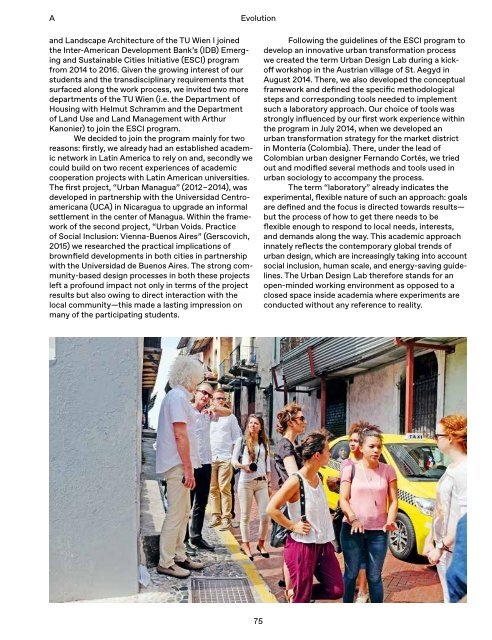Urban Design Lab Handbook – Dialogue-oriented urban transformation processes and practical approaches from Latin America and the Caribbean
ISBN 978-3-86859-562-8 https://www.jovis.de/en/books/preview/product/urban-design-lab-handbook.html
ISBN 978-3-86859-562-8
https://www.jovis.de/en/books/preview/product/urban-design-lab-handbook.html
Create successful ePaper yourself
Turn your PDF publications into a flip-book with our unique Google optimized e-Paper software.
A<br />
Evolution<br />
<strong>and</strong> L<strong>and</strong>scape Architecture of <strong>the</strong> TU Wien I joined<br />
<strong>the</strong> Inter-<strong>America</strong>n Development Bank’s (IDB) Emerging<br />
<strong>and</strong> Sustainable Cities Initiative (ESCI) program<br />
<strong>from</strong> 2014 to 2016. Given <strong>the</strong> growing interest of our<br />
students <strong>and</strong> <strong>the</strong> transdisciplinary requirements that<br />
surfaced along <strong>the</strong> work process, we invited two more<br />
departments of <strong>the</strong> TU Wien (i.e. <strong>the</strong> Department of<br />
Housing with Helmut Schramm <strong>and</strong> <strong>the</strong> Department<br />
of L<strong>and</strong> Use <strong>and</strong> L<strong>and</strong> Management with Arthur<br />
Kanonier) to join <strong>the</strong> ESCI program.<br />
We decided to join <strong>the</strong> program mainly for two<br />
reasons: firstly, we already had an established academic<br />
network in <strong>Latin</strong> <strong>America</strong> to rely on <strong>and</strong>, secondly we<br />
could build on two recent experiences of academic<br />
cooperation projects with <strong>Latin</strong> <strong>America</strong>n universities.<br />
The first project, “<strong>Urban</strong> Managua” (2012 <strong>–</strong> 2014), was<br />
developed in partnership with <strong>the</strong> Universidad Centroamericana<br />
(UCA) in Nicaragua to upgrade an informal<br />
settlement in <strong>the</strong> center of Managua. Within <strong>the</strong> framework<br />
of <strong>the</strong> second project, “<strong>Urban</strong> Voids. Practice<br />
of Social Inclusion: Vienna-Buenos Aires” (Gerscovich,<br />
2015) we researched <strong>the</strong> <strong>practical</strong> implications of<br />
brownfield developments in both cities in partnership<br />
with <strong>the</strong> Universidad de Buenos Aires. The strong community-based<br />
design <strong>processes</strong> in both <strong>the</strong>se projects<br />
left a profound impact not only in terms of <strong>the</strong> project<br />
results but also owing to direct interaction with <strong>the</strong><br />
local community—this made a lasting impression on<br />
many of <strong>the</strong> participating students.<br />
Following <strong>the</strong> guidelines of <strong>the</strong> ESCI program to<br />
develop an innovative <strong>urban</strong> <strong>transformation</strong> process<br />
we created <strong>the</strong> term <strong>Urban</strong> <strong>Design</strong> <strong>Lab</strong> during a kickoff<br />
workshop in <strong>the</strong> Austrian village of St. Aegyd in<br />
August 2014. There, we also developed <strong>the</strong> conceptual<br />
framework <strong>and</strong> defined <strong>the</strong> specific methodological<br />
steps <strong>and</strong> corresponding tools needed to implement<br />
such a laboratory approach. Our choice of tools was<br />
strongly influenced by our first work experience within<br />
<strong>the</strong> program in July 2014, when we developed an<br />
<strong>urban</strong> <strong>transformation</strong> strategy for <strong>the</strong> market district<br />
in Montería (Colombia). There, under <strong>the</strong> lead of<br />
Colombian <strong>urban</strong> designer Fern<strong>and</strong>o Cortés, we tried<br />
out <strong>and</strong> modified several methods <strong>and</strong> tools used in<br />
<strong>urban</strong> sociology to accompany <strong>the</strong> process.<br />
The term “laboratory” already indicates <strong>the</strong><br />
experimental, flexible nature of such an approach: goals<br />
are defined <strong>and</strong> <strong>the</strong> focus is directed towards results—<br />
but <strong>the</strong> process of how to get <strong>the</strong>re needs to be<br />
flexible enough to respond to local needs, interests,<br />
<strong>and</strong> dem<strong>and</strong>s along <strong>the</strong> way. This academic approach<br />
innately reflects <strong>the</strong> contemporary global trends of<br />
<strong>urban</strong> design, which are increasingly taking into account<br />
social inclusion, human scale, <strong>and</strong> energy- saving guidelines.<br />
The <strong>Urban</strong> <strong>Design</strong> <strong>Lab</strong> <strong>the</strong>refore st<strong>and</strong>s for an<br />
open-minded working environment as opposed to a<br />
closed space inside academia where experiments are<br />
conducted without any reference to reality.<br />
75


















